CLICK HERE TO GO BACK TO BEIJINGWUSHUTEAM.COM
CLICK HERE TO GO TO THE WUSHU NEWS
2002 Revised Rules and Judging System for Chinese Wushu Competitions
by
Brandon Sugiyama
(11/28/02)
[Webmasters' Note - Thanks to Brandon for sharing these interesting new developments in our sport with us. The photos included in the article are from the 2002 China Nationals held in Zhangzhou, Fujian, China in September 2002. Videos of the competition are available by clicking here].
The following is a summary of the currently revised judging and scoring system for wushu competitions in China. This is the system that was recently implemented at the 2002 Chinese Nationals in Fujian. This summary is translated from a presentation by Coach Li Qiaoling, an instructor at the Beijing Tiyu Daxue and a certified judge who served at the 2002 Nationals.
NOTE: These rules DO NOT apply to wushu competitions outside of China. These rules will continue to undergo development and may change before next year's Chinese nationals.
Click each picture for additional information
JUDGES

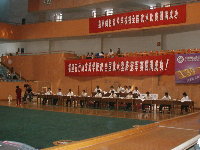
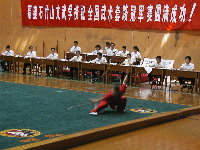
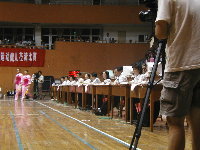
There are a total of 12 judges.
1 through 10 are lined up side by side along the length of the competition carpet. 11 and 12 are positioned behind and slightly above 1 through 10.
There are 3 types of judges: A, B and C. Each type scores on different factors:
- A: 1, 3, 5, 7 and 9 score on basic wushu techniques and award a total of 5 points.
- B: 2, 4, 6 and 8 score for tempo, speed, power and presentation and award a total of 2 points.
- C: 11 and 12 score for difficulty moves and award a total of 3 points.
A, B and C judges scores are summed for a total of 10 points.
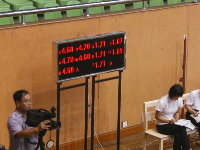
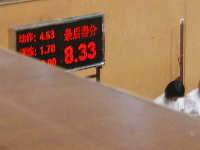

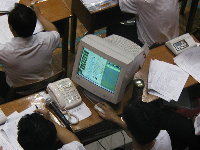
DIFFICULTY MOVES AND POINTS
Category C judges award and deduct points according to difficulty moves (Mandarin is "nan du"). This category awards a total of 3 out of the 10 total points.
There are three levels of difficulty moves:
- A level awards +0.2 points.
- B level awards +0.4 points.
- C level awards +0.6 points.
There are several different types of difficulty moves. Within each type, there are 3 levels that correspond to the A, B and C levels mentioned above.
TYPES OF DIFFICULTIES
- BALANCES - Lifting the leg with one hand while standing upright will award +0.2 points (A). A swallow balance with the leg completely straight up (perpendicular to the ground) can award +0.4 points (B). A balance where the competitor can reach behind and grab the leg with both hands and pull it straight up against the back can award +0.6 points (C).
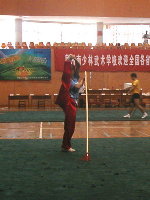
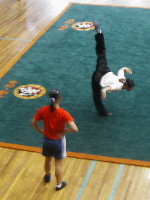
- SWEEPS - A front sweep with one full rotation can award +0.2 points (A). A front sweep with two full rotations can award +0.4 points (B).
- JUMPS AND AERIAL TECHNIQUES - A jump inside kick with a 360 turn can award +0.2 points (A). A jump inside kick with a 540 turn can award +0.4 points (B). A jump inside kick with a 720 turn can award +0.6 points (C). A standard butterfly can award +0.2 points (A). A butterfly twist can award +0.4 points (B). A double butterfly twist (720) can award +0.6 points (C). For jumps and aerial techniques, a competitor must land in a stance or a split for the B and C level. If the competitor successfully lands in a stance or split, they can be awarded and additional +0.2 points for the B level and +0.3 points for the C level. If a competitor attempts a B or C level jump and does not land properly, they will still get the +0.4 or +0.6 points, but not the additional +0.2 or +0.3 points.
NOTE: There is currently no point system for directly awarding competitors for jumping combinations. A competitor that does a jump inside to 720 butterfly twist to splits will be awarded the same amount of points for a competitor that does a jump inside in one run, then a 720 butterfly twist to splits in another run. The only possible award in this case would be from the B judges who award a total of 2 points for presentation. Also of note, competitors who clearly stop the flow of the form in preparation for a difficult jump (ie. Stopping, standing for a moment and taking a long run before a 720 jump) may be deducted by the B judges for poor presentation.
- WEAPONS - Throwing the weapon in the air and completing a sweep or roll before catching the weapon can award +0.4 points. Completing a 360 degree jump inside kick while the weapon is in the air can award +0.5 points. Completing a 360 degree jump outside kick while the weapon is in the air can award +0.6 points.
STARTING AND ENDING POINT OF FORMS
There are no longer any requirements for starting and ending on the same side of the carpet. No requirements for what direction the competitor should be facing when starting or ending a form.

WEAPONS REQUIREMENTS
Length of weapons are determined according to the competitors height. For example, a competitor of X centimeters in height would refer to a chart where X corresponds to a particular # of weapon. Swords are now numbered according to length from 1-7.
Last modified: November 28, 2002
Click Here to go back to beijingwushuteam.com
Send feedback to
raffi at beijingwushuteam.com